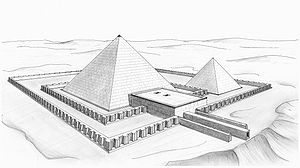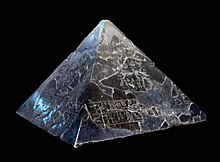Chendjer pyramid
| Chendjer pyramid | ||||||||||||||||||||
|---|---|---|---|---|---|---|---|---|---|---|---|---|---|---|---|---|---|---|---|---|
|
||||||||||||||||||||
The Chendjer pyramid is located in Saqqara south on the western bank of the Nile about 30 kilometers south of Cairo . It dates to the 13th dynasty (around 1750 BC) and is one of the few pyramids of this period that is believed to have been completed. In a survey by the German Archaeological Institute in spring 2006, the pyramid was given the designation SAK S 5.
exploration
The pyramid was first mapped by Karl Richard Lepsius , who assigned it the number XLIV in his list of pyramids . At the beginning of the 20th century, the pyramid was excavated and examined by Gustave Jéquier .
Details
The adobe pyramid was originally about 37.75 m high, had an inclination angle of 55 ° and a base length of 52.5 m, which corresponds to 100 cubits. Today the building is just one meter high. The outer cladding was made of limestone . On the top there was a pyramidion made of black granite , which was labeled and decorated .
The entrance to the great pyramid was to the west. A staircase led to a chamber that should originally have been blocked by a gigantic stone, but which was still in waiting position in a niche in the wall, so that the access was never closed at this point. After a long, winding corridor, another barrier followed, and behind it the burial chamber , which was embedded in a monolithic quartzite block . Two blocks formed the ceiling, over which there was a gable roof made of limestone, which served to relieve the burial chamber from the pressure of the stone loads above.
To the north of the pyramid was a second, smaller pyramid, in which family members were likely to be buried. Two sarcophagi and canopic boxes were found in their burial chambers . Furthermore, a canopic fragment with the name of the king's wife Seneb ... (rest of the name not preserved) was found in the pyramid district . The name can possibly be added to Seneb [henaes].
There was a mortuary temple in front of the east side of the pyramid, and found relief fragments indicate that it may have been completed and fully decorated. The pyramid complex was surrounded by two enclosing walls, the inner wall enclosing the actual pyramid, the mortuary temple and the north chapel, while the outer wall led around the entire complex, including the secondary pyramid.
See also
literature
- Gustave Jéquier : Deux pyramides du Moyen Empire (= Fouilles à Saqqarah. Volume 68). Institut Français d'Archéologie Orientale, Cairo 1933, pp. 3–35 ( online ).
- Jean-Philippe Lauer : The royal tombs of Memphis: excavations in Saqqara (= Lübbe collection. ). Lübbe, Bergisch Gladbach 1988, ISBN 3-7857-0528-X .
- Mark Lehner: The first wonder of the world. Düsseldorf 1997, ISBN 3-430-15963-6 , pp. 186-187.
- Miroslav Verner : The pyramids (= rororo non-fiction book. Volume 60890). Rowohlt, Reinbek bei Hamburg 1999, ISBN 3-499-60890-1 , pp. 480-481.
Web links
Individual evidence
- ^ Robert Schiestl: News on the residential necropolis of the 13th dynasty: Survey in Dahshur-North / Saqqara-South and Dahshur-South. In: Sokar 13 (2006) , pp. 46-52.
Coordinates: 29 ° 49 ′ 56.5 ″ N , 31 ° 13 ′ 25.6 ″ E



